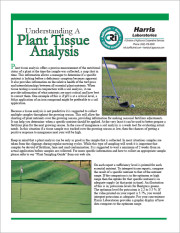Understanding a Plant Tissue Analysis

Plant tissue analysis offers a precise measurement of the nutritional status of a plant at the time the sample was collected; a snap shot in time. This information allows a manager to determine if a specific nutrient is lacking before a deficiency symptom becomes apparent. It also provides information on the relative health of the turf grass and interrelationships between all essential plant nutrients. When tissue testing is used in conjunction with a soil analysis, it can provide information of what nutrients are most critical and how best to correct them. One example of this is if pH is at a critical level, a foliar application of an iron compound might be preferable to a soil application.
Because a tissue analysis is not predictive it is suggested to collect multiple samples throughout the growing season. This will allow the charting of plant nutrients over the growing season, providing information for making seasonal fertilizer adjustments. It can help you determine: when a specific nutrient should be applied. At the very least it can be used to better prepare a fertilizer plan for the next growing season. In the case of manganese a soil analysis is a weak tool for evaluating actual needs. In this situation if a tissue sample was tracked over the growing season as low, then the chances of getting a positive response to manganese next year will be high.


